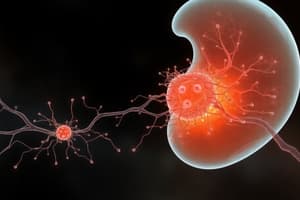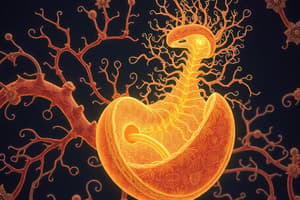Podcast
Questions and Answers
What are the two parts into which somites differentiate?
What are the two parts into which somites differentiate?
- Ectoderm and Endoderm
- Mesoderm and Neural Crest
- Myotome and Dermis
- Sclerotome and Dermomyotome (correct)
Which part of the dermomyotome becomes myoblasts?
Which part of the dermomyotome becomes myoblasts?
- Sclerotome
- Dermatome
- Fibroblast region
- Myotome (correct)
What process transforms mesenchyme into bone through an initial cartilage formation?
What process transforms mesenchyme into bone through an initial cartilage formation?
- Endochondral ossification (correct)
- Intramembranous ossification
- Mesenchymal condensation
- Chondrogenesis
What initiates selective gene activity in mesenchyme leading to cell differentiation?
What initiates selective gene activity in mesenchyme leading to cell differentiation?
Which protein is encoded by HOX genes and is involved in chondrogenesis?
Which protein is encoded by HOX genes and is involved in chondrogenesis?
What is the primary role of mesenchyme during skeletal development?
What is the primary role of mesenchyme during skeletal development?
Which type of ossification occurs primarily in flat bones?
Which type of ossification occurs primarily in flat bones?
What characteristic describes mesenchyme in the context of bone formation?
What characteristic describes mesenchyme in the context of bone formation?
What primarily regulates the thickness of compact bone and the size of the medullary cavity?
What primarily regulates the thickness of compact bone and the size of the medullary cavity?
What is the function of the paraxial plates in the intraembryonic mesoderm?
What is the function of the paraxial plates in the intraembryonic mesoderm?
Which of the following accurately describes the sclerotome, myotome, and dermatome?
Which of the following accurately describes the sclerotome, myotome, and dermatome?
What does the postotic part of the paraxial mesoderm primarily consist of?
What does the postotic part of the paraxial mesoderm primarily consist of?
What is the primary origin of the cells that line the deep surface of the ectoderm?
What is the primary origin of the cells that line the deep surface of the ectoderm?
What types of mesoderm contribute to the formation of the shoulder, hip girdle, and limbs?
What types of mesoderm contribute to the formation of the shoulder, hip girdle, and limbs?
At birth, which of the following statements accurately describes the ossification status of bones?
At birth, which of the following statements accurately describes the ossification status of bones?
Which embryonic structure is responsible for giving rise to the vertebral column and ribs?
Which embryonic structure is responsible for giving rise to the vertebral column and ribs?
When do somites first appear during embryonic development?
When do somites first appear during embryonic development?
What happens to the cartilage plate when growth is completed?
What happens to the cartilage plate when growth is completed?
What is indicated by the presence of vascular connective tissue invasion during somite development?
What is indicated by the presence of vascular connective tissue invasion during somite development?
By what age does the epiphysis and diaphysis typically fuse, marking the cessation of bone elongation?
By what age does the epiphysis and diaphysis typically fuse, marking the cessation of bone elongation?
Which structure is primarily responsible for the development of bones in the face and skull?
Which structure is primarily responsible for the development of bones in the face and skull?
Which cartilaginous center surrounds the hypophysis cerebri?
Which cartilaginous center surrounds the hypophysis cerebri?
What type of ossification occurs in the mesenchyme of the cranial vault?
What type of ossification occurs in the mesenchyme of the cranial vault?
Which of the following structures is NOT formed from mesoderm within the pharyngeal arches?
Which of the following structures is NOT formed from mesoderm within the pharyngeal arches?
Where do the parachordal cartilages appear during development?
Where do the parachordal cartilages appear during development?
Which part of embryonic development does the viscerocranium involve?
Which part of embryonic development does the viscerocranium involve?
The fusion of which cartilages contributes to forming various parts of the skull?
The fusion of which cartilages contributes to forming various parts of the skull?
What anatomical feature helps in distinguishing the skull of a newborn?
What anatomical feature helps in distinguishing the skull of a newborn?
What is the primary contribution to the mesenchyme involved in forming the cranial vault?
What is the primary contribution to the mesenchyme involved in forming the cranial vault?
Which type of cartilage is characterized as the most widely distributed type in the body?
Which type of cartilage is characterized as the most widely distributed type in the body?
What type of cartilage is primarily found in intervertebral discs?
What type of cartilage is primarily found in intervertebral discs?
Which statement correctly describes mesenchyme in the context of intramembranous ossification?
Which statement correctly describes mesenchyme in the context of intramembranous ossification?
Which of the following structures is an example of elastic cartilage?
Which of the following structures is an example of elastic cartilage?
Which type of cell is primarily responsible for the formation of new bone during intramembranous ossification?
Which type of cell is primarily responsible for the formation of new bone during intramembranous ossification?
What occurs during the remodeling of bone involving osteoclasts?
What occurs during the remodeling of bone involving osteoclasts?
Which type of cartilage is known for providing support with some flexibility?
Which type of cartilage is known for providing support with some flexibility?
What process occurs without prior cartilage formation during bone development?
What process occurs without prior cartilage formation during bone development?
What type of connective tissue acts as the precursor to bone during the initial stages of ossification?
What type of connective tissue acts as the precursor to bone during the initial stages of ossification?
What feature is characteristic of spongy bone compared to compact bone?
What feature is characteristic of spongy bone compared to compact bone?
Flashcards are hidden until you start studying
Study Notes
Formation and Differentiation of Somites
- At the end of the third week, the embryonic dorsolateral columns develop into somites.
- Somites consist of two primary parts: the sclerotome and the dermomyotome.
Sclerotome
- The ventromedial part of the somite forms the sclerotome, which gives rise to vertebrae and ribs.
- Mesenchyme transforms into cartilage followed by ossification through endochondral formation.
Dermomyotome
- The dermomyotome is divided into:
- Myotome: differentiates into myoblasts, which are the precursors to muscle cells.
- Dermatome: develops into fibroblasts that contribute to the dermis of the skin.
Ossification Processes
- Bone formation occurs via two main processes:
- Intramembranous ossification: mesenchyme directly transforms into bone.
- Endochondral ossification: mesenchyme first becomes cartilage before converting to bone.
- The process of condensation in mesenchyme leads to selective gene activity, initiating cell differentiation.
Types of Cartilage
- Three types of cartilage relevant to skeletal development:
- Hyaline cartilage: most widely distributed, crucial for joint formation; programmed early in development.
- Fibrocartilage: found in structures such as intervertebral discs.
- Elastic cartilage: present in structures like the auricles of the external ears.
Intraembryonic Mesoderm
- There are divisions within the intraembryonic mesoderm:
- Paraxial mesoderm: forms somites along the sides of the notochord and neural tube, producing structures like the membranous labyrinth of the ear.
- Segmentations of paraxial mesoderm lead to about 40-45 pairs of somites.
Development of Bones
- Bone development is influenced by endogenous regulators including HOX genes and bone morphogenic proteins (BMP5, BMP7).
- Secondary ossification centers in the epiphyses appear during early childhood, with epiphyseal cartilage hypertrophying during growth.
- Growth in bone diameter results from periosteal deposition and internal resorption, continuously reorganizing throughout life.
Maternal Nutritional Needs
- Pregnant women are advised to maintain adequate calcium and phosphorus levels for proper fetal bone development.
At Birth
- At birth, diaphyses are largely ossified while epiphyses remain cartilaginous.
- By age 20, the epiphysis and diaphysis fuse, concluding longitudinal bone growth.
Skull Development
- The neurocranium develops through intramembranous ossification within mesenchyme, contributing to the cranial vault.
- The viscerocranium, or facial skeleton, arises from neural crest cells and includes bones developed from pharyngeal arches.
Clinical Considerations
- Malformations such as pectus carinatum (pigeon chest) and pectus excavatum (funnel chest) are associated with chest wall anomalies derived from skeletal development processes.
Studying That Suits You
Use AI to generate personalized quizzes and flashcards to suit your learning preferences.



